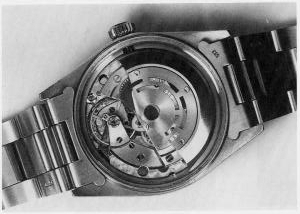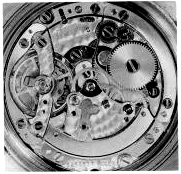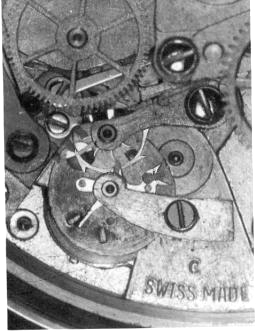- Where
George Daniels shopped the
Co-Axial...
- Originally
written by Curtis
Thomson
on 17 June 2001, 11:57am CT,
Last Revision, 20 June 2001, 7:30pm CT,
Certain
Rights Reserved...
- For twenty plus years
George Daniels had attempted to introduce his
escapement to the Swiss industry. The story is well
documented, so I will not proceed on that path, but I
do have some examples of "industry" watches, which he
fitted the Co-Axial to in hopes of impressing upon his
audience how his escapement is adaptable to their
watches.
-
- The pictures are B&W
and do not always display the escapement well, but
trust that, indeed, the Co-Axial is present and
working.
-
- This first lot of
photos show an Omega 1045 from 1975 and
1996:
-
- These pictures are of
a Patek from 1980.
-
- This pair is of a
Rolex from 1989 and 1996.
-
|
|

|
|

|
|
|
1989
|
|
1996
|
- These two show an
Urban Jürgensen (Piguet movement I imagine) and a
Zenith. Both from 1983...
-
|
|

|
|

|
|
|
Urban
Jürgensen
|
|
Zenith
El-Primero
|
- There are many reasons
why these companies entertained Daniels and many
reasons why they decided to pass on the escapement. It
does seem that in the main it was an issue of expense
to retool and develop the escapement for series and
that it was an unknown quantity, which was made in
one-offs for the connoisseur. Daniels, of course,
believes it was an issue of Swiss pride and lack of
understanding, which he still probably believes, as
Omega lubricated his escapement and did not follow his
advise for the vph.
-
- Again, I am sorry for
the poor quality of the scans. They do not clearly
show the escapement, as I had wished, but do give the
impression and demonstrate Daniels dogged efforts to
introduce his escapement to the Swiss industry.
-
- Cheers,
-
- Curtis
(curtisdthomson@yahoo.com)
-
- Photos are from Daniels'
book The Practical Watch Escapement.
-
- The author would like to
acknowledge the assistance of Chuck
Maddox who did
the HTML presentation, "tweaked" the photo's for
better visibility, and who is hosting this
page...
-
- 17
June 2001 Addendum:
-
- On 17 June 2001 at 22:59
"Richie" posted:
- Hi Richie,
-
- I am unsure of what his
"deal" with Hayek was in terms of purchasing the
rights to use the Daniels Co-Axial, although, it did
take a year to reach an agreement. I do know that one
of the tough bits to iron out, during negotiating, was
the continued use of the Daniels Co-Axial escapement
by George Daniels. He maintained he must be permitted
to use HIS escapement in watches he makes.
Additionally, Daniels wanted a fixed number of
ebauches to be made available to him. Both terms were
met. Incidentally, the 50 ebauches were made available
to Daniels in 1999. He hired a young watchmaker, Roger
Smith, to help construct and finish these ebauches.
The last of the 50 will be completed this year.
-
- This is one of the
completed series of 50 Daniels London watches (ETA
ebauche):
-

|
|
--
Photo by Colin Chrisford
|
- The particulars of this
watch may be found at http://www.daniels-london.co.uk
-
- Daniels applied for a
patent in 1980. He received a reply from the patent
office that there were three other patented
escapements prior to his own application, which
pre-empted his application. The three examples were,
as quoted by Daniels, "...the single lift Robin, which
gives impulse only at alternate vibrations, the double
lift Robin by Breguet which needs oil, and the Fasholt
which is a single lift escapement."
-
- Daniels went through two
years of debating the merits and differences of his
escapement to the three mentioned. He enlisted the
help of noted horologists to write letters to the
patent office, on his behalf, explaining the
uniqueness of his escapement. Even after these
measures his patent was not given. Finally, his
application was re-written including the words "the
locking and impulse pallets have entirely separate
functions." Those words did the trick. He was given
his patent, as none of the three others mentioned used
those words, thus, his was original. Daniels was
obviously pleased, but frustrated with the
horologically ignorant determining and validating his
escapement. His patent was post-dated to 1980. Oh, the
bureaucracy of the world...
-
- So, with patent in hand,
he was able to safely shop and discuss his escapement
with the industry.
-
- Hope this helps.
-
- Cheers,
-
- Curtis
(mailto:curtisdthomson@yahoo.com)
-
- All above information
may be found in George Daniels' Autobiography "All In
Good Time"
-
-
- The
George Daniels & Patek Philippe
Thread:
-
-
George
Daniels & Patek
Philippe>>>
- Posted By:
Curtis <curtisdthomson@yahoo.com>
(tcache-wl01.proxy.aol.com)
- Date: 6/19/1 -
09:00:21
-
- I recently posted on the
PF (link below), regarding Daniels and his fitting the
Co-Axial in other makers movements. I found his story
with Patek especially interesting.
-
- In 1979 Daniels was
approached by Patek "the most prestigious watch makers
in the industry". Their English sales director and
their chief of Research & Development went to
Daniels' workshop in London to discuss his new
Co-Axial escapement. After the meeting, it was decided
that Patek would undertake the task of prototyping the
escapement for a pocket watch and test its efficiency.
-
- In February 1980 the
prototyping began. "From the beginning," writes
Daniels, "I sensed a slight air of antogonism in our
discussions." He understood this to an extent, as he
would not appreciate a foreigner interfering in his
workshop. With this in mind, he keeps a low profile.
"Sometimes, to flatter them, I asked for advice in
order to show appreciation of their undoubtedly
superior technical education. Their answers were
grudgingly given as if to avoid improving my
education."
-
- After a year and more
the prototype was finished. Daniels comments that is
was beautifully made, as one expects from Patek.
"But," he writes, "it was prone to stop occassionally
especially when moved about. In fact, it stopped there
and then as I looked at it." A technician proded the
movement and it started again. Daniels looked at the
drawings and saw where the flaw was, which Patek was
aware of, as well. He mentioned this to the
draughtsman, who upon hearing the error mentioned,
took his drawings and left. The chief said, "...it was
not a mistake but a deliberately applied different
philosophy of design!"
-
- Daniels writes, "I did
not enjoy my visits to the factory. The prime reason
was the obvious resentment of my presence, but more
depressing was the realisation that these men were
essentially technicians who had no love of the romance
and intellectual pleasure of the conception, design
and construction of a beautiful and original work of
art. To them, watchmaking was a practical way of
making a living, and the less original thought
required the easier the work would be."
-
- To try and rectify the
situation, he suggests they attempt to put the
escapement into a wristwatch. The chief liked the idea
and produced a 2.5 mm thick movement for the
escapement to be fitted to. Daniels had previously, on
his own whim, put the co-axial into an Omega
Speedmaster, but was not sure he could do so to such a
thin watch. He was sure the chief held the same
opinion and "I [Daniels] realised that I had
been outwitted." If he couldn't fit it to a modern
watch than there was no point in progressing this
work. He went back to London to solve the problem.
-
- Three weeks later he
produced, to Patek, a redesigned, made, adjusted and
fitted escapement to the R&D team in Geneva. He
says he felt some admiration from Patek at his
solution.
-
- It was decided that
three wristwatch sized prototypes would be made. The
drawings were discussed and Daniels saw one stumbling
block, the proportion of the extra driving wheel.
Patek rejected his notion, even in the face of Daniels
working, Patek provided movement, prototype.
-
- By 1982 his prototype
was cased and dialed from the Patek factory. He says
he gave the watch daily use for twelve years, when the
self winding mechanism failed. "That it should have
lasted so long without servicing is a tribute to Patek
Philippe's production and design of so slim and
delicate a movement." It was not serviced to test the
effectiveness of the escapement over a ten year
period. The escapement functioned perfectly.
-
- In 1984 the R&D
prototypes were not working properly and one was sent
to a specialist escapement maker for the industry. The
analysis was quite critical and the prime fault was in
the gears, which Daniels had mentioned at the
beginning of the project. A letter was included with
the movement saying that the movement was only the
conception and principles of Mr. Daniels system. It
was also mentioned that Daniels prototype worked. This
was done to protect Daniels reputation.
-
- Daniels had one last
meeting with R&D. He wore his Patek prototype and
his pocket watch prototype, which both worked. The
chief of R&D came in and quickly said, "We cannot
make your escapement." That was the end of his four
years relationship with Patek Philippe.
-
- The three prototypes
were given to Daniels. One of which, is in the
Worshipful Company of Clockmakers Museum in Guild Hall
Library.
-
- While I question Daniels
account regarding his poise and tact, as his will and
temper are legendary, I do believe the facts and
information, in principle, to be truthful.
-
- I hope you enjoyed this
read.
-
- Cheers,
-
- Curtis
-
- Fascinating
story. It would be great
(more)
- Posted By: bob
<egraphic@ix.netcom.com> (209.179.40.50)
- Date: 6/19/1 -
10:37:53
-
- In Response To:
George
Daniels & Patek Philippe>>> (Curtis)
-
- to get the Patek side of
the discussions. I don't doubt the competitive tone of
the interchange, but it would be sad to learn that
"these men were essentially technicians who had no
love of the romance and intellectual pleasure of the
conception, design and construction of a beautiful and
original work of art," as suggested by Daniels. Some
of the great Patek movements would not seem to support
this view of their orientation. Of course, as in any
trade, there are the designers and those who execute
the design - often very different types of people.
-
- I am no watch expert,
but I also understand that the escapement (as you
indicate) had serious practical issues to overcome -
as is often true of new mechanical designs. I know of
at least one watchmaker on these pages who does not
predict longevity for individual examplars with the
finally designed escapement. It is possible that Patek
concluded, after much time on the effort (early on, it
should be noted), that the final practical output
would not meet their expectations. Perhaps Omega will
prove them incorrect.
-
- I do have a question -
do you know if Daniels spent any serious time with
Blancpain?
-
- Very fine work, thank
you!
-
- bob
-
- Thanks
(more)
- Posted By:
Curtis <curtisdthomson@yahoo.com>
(152.163.194.137)
- Date: 6/19/1 -
14:54:44
-
- In Response To:
Fascinating
story. It would be great (more) (bob)
-
- Hi Bob,
-
- He gives no indication
that Blancpain was a participant in his quest to
introduce the Co-Axial into the mainstream industry.
This could be due to the infancy of Blancpain at the
beginning of his quest. By the companies he chose, it
seems apparent that he wanted companies with an
established track record.
-
- The problems Omega
recently faced and Patek faced are different. Omega
did have tolerance problems (the impulse jewel on the
lever would sometimes hit the crossings of the escape
wheel). They also had a problem with an incorrect
setting on the lubrication machine used during
assembly, which led to over oiling the escape wheel on
some movements. In use, the oil would creep down to
the pinion and onto the intermediate wheel. These
problems have been addressed.
-
- Patek's issue was the
incorrect proportion of the intermediate wheel.
-
- In both cases neither
Patek nor Omega would heed the advice of George
Daniels, whose escapements worked.
-
- I imagine it could be
one of a hundred reasons, or a combination of them
all, that turned Patek and the others away from the
Co-Axial. It may have been as simple as "Not Swiss
Made." It may turn out to be too complicated to make
on a mass production scale? Time will tell.
-
- I have heard the
negative talk from watchmakers, as well. I have also
heard very positive talk from watchmakers, too, and
who are of the highest esteem within the industry.
-
- George Daniels is quick
to point out that the lever escapement is two hundred
years of development to the stage we see it in modern
times. He figures the Co-Axial will need the same
commitment for it to reach its full production
efficiency.
-
- I hope this helps.
-
- Cheers,
-
- Curtis
-
- Daniels'
story reminds me of John Harrison's
(more)
-
- Posted By: bob
<egraphic@ix.netcom.com> (209.179.40.50)
- Date: 6/19/1 -
17:14:51
-
- In Response To:
Thanks
(more) (Curtis)
-
- in the resolution of the
longitude problem that spanned the middle of the
eighteenth century. (I just finished reading Dava
Sobel's Longitude. I know, I know, I'm way late
getting around to it).
-
- In any event, many
contemporary watchmakers tried to second-guess
Harrison in their copycat designs, often leaving out
significant elements, or using inexpensive materials
in the hopes of duplicating his successes. Then there
were the doubting Thomases on the Board of Longitude,
who predominently favored a lunar (non-mechanical)
solution, and put Harrison's invention through decades
of needlessly rigorous testing.
-
- bob
-
-
- Statement
of rights retained and permissions
granted...
-
- Permission for personal,
educational or non-commercial use is granted.
The
author retains
all other rights not specifically mentioned here...
For all other use please contact
the author.
|